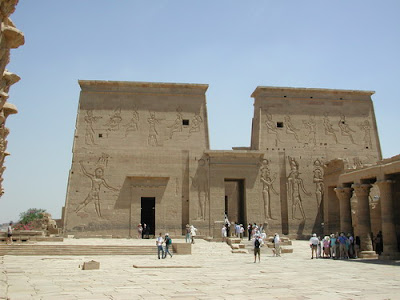Wednesday, September 26, 2012
Egypt day 13 Sunday, 6 November Aswan and Island of Philae
This morning we headed for the beautiful Philae Temple which was located on a picturesque island in the middle of the Nile. We were transported by motorboat crewed by Nubians, a friendly and handsome people, who brought s lot of their colourful wares to sell to us on the trip just laying them out around the boat for us to see and make our choices. We all purchased many souvenirs as it was wonderful not to be hassled.
Temple of Philae
Philae Island was a rocky island in the middle of the River Nile, south of Aswan . It was called in Hieroglyphic "Apo" which means Ivory. It was also known by the Greek "Elephantine", most probably because it was an important centre of trade, especially for ivory.
The Ancient Egyptians built a beautiful and magnificent Temple on this island for the Goddess Isis, but the Temple became submerged after the first Aswan dam was built in 1906, and it was not until the seventies that many nations attempted to save the Temple. All these countries, together with UNESCO, selected a suitable place, but they had to wait until the completion of the High Dam, in 1971, which would stabilize the level of the water around their chosen island. The new island was called Egilica (also calledAgilika), and it was completely reshaped to imitate Philae Island as closely as possible.
Firstly, a coffer dam was built around the Temple and the water was drained. Next, the Temple was dismantled and transferred, stone by stone, from the submerged Philea Island to the redesigned Egilica Island. Each and every stone had to be numbered, and then replaced, in the same position, in the new location. It was a massive, and very complicated, project taking over 9 years to be accomplished.
The Temple of Philae was reopened in 1980!
The Temple of Isis
The Temple of Isis is one of the greatest Temples in Egypt and it occupies about a quarter of the island. It is the main Temple on the island, with its huge, complete, pylons and beautiful scenes.
The construction began during the reign of King Ptolemy II, and then other Ptolemaic Kings (Ptolemy's IV, V, VI, VII and XI) contributed by adding more parts to the main Temple.
The Temple is built in the same style as the Temples of the New Kingdom, as well as some other elements, which appeared in the Greco-Roman period, such as the Mamisi (the House of the divine birth of Horus), and a Nilometer.
The Temple of Isis consists of The 1st Pylon, which is a great traditional pylon with two towers, and an open forecourt, which leads to the 2nd pylon.
On the left side of this court is the Mamisi, which has scenes depicting the birth of the God Horus by his mother Isis.
The 2nd Pylon leads to a Hypostyle Hall with 10 columns, and then 3 vestibules leading to a sanctuary.
The oldest remains, of the Temple of Philae, date back to the reign of King Taharqa (25th Dynasty), who built the first chapel for the Goddess Isis.
In addition to the main Temple of Isis there are other monuments here, such as The Kiosk of Trajan, the Chapel of Osiris, The Temple of Horus, The Temple of Hathor, The Gateway of Tiberius, the Gateway of Diocletian, and the Temple of Augustus.
The Temples of the island were neglected, and some of them even destroyed, after the persecution of the Christians by the Roman Emperors. During the reign of the Emperor Justinian (527-565 A.D), the main Temple was converted to a church.
On the way back from the temple to the boat we stopped at the Sandallia Papyrus factory and gallery and a charming young girl demonstrated the making of Papyrus. We were brought here by Hanan as she advised that most of the Papyri on sale in the markets was painted on banana leaves and would deteriorate quickly. We made our purchases and returned to the ship for lunch.
Our free choice afternoon activity was a felucca ride along the Nile. The weather was beautiful with a slight breeze blowing as we gently glided along the Nile enjoying the many sights along the way included a view of the hotel that Agatha Christie stayed at when she wrote Death on the Nile.
After dinner we enjoyed a Nubian show with traditional Nubian music, dancing and even a whirling dervish. This was most entertaining.
Subscribe to:
Post Comments (Atom)





















No comments:
Post a Comment